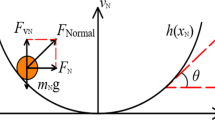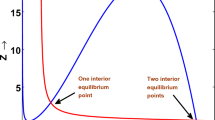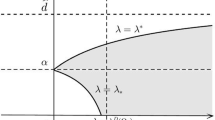Abstract
A class of nonautonomous discrete logistic single-species systems with time-varying pure-delays and feedback control is studied. By introducing a new research method, almost sufficient and necessary conditions for the permanence and extinction of species are obtained. Particularly, when the system degenerates into a periodic system, sufficient and necessary conditions on the permanence and extinction of species are obtained. Moreover, a very important fact is found in our results, that is, the feedback control and delays are harmless for the permanence and extinction of species for discrete single-species systems. This shows that in a discrete single-species system introducing the feedback control to factitiously control the permanence and extinction of species is useless.
Similar content being viewed by others
References
R.P. Agarwal: Difference Equations and Inequalities: Theory, Methods, and Applications. Marcel Dekker, New York, 1992.
R.P. Agarwal, W.-T. Li, P.Y.H. Pang: Asymptotic behavior of a class of nonlinear delay difference equations. J. Difference Equ. Appl. 8 (2002), 719–728.
M. Bohner, M. Fan, J. Zhang: Existence of periodic solutions in predator-prey and competition dynamic systems. Nonlinear Anal., Real World Appl. 7 (2006), 1193–1204.
E. Braverman: On a discrete model of population dynamics with impulsive harvesting or recruitment. Nonlinear Anal., Theory Methods Appl., Ser. A 63 (2005), 751–759. (Electronic only).
E. Braverman, S.H. Saker: Permanence, oscillation and attractivity of the discrete hematopoiesis model with variable coefficients. Nonlinear Anal., Theory Methods Appl. 67 (2007), 2955–2965.
F. Chen: Permanence in a discrete Lotka-Volterra competition model with deviating arguments. Nonlinear Anal., Real World Appl. 9 (2008), 2150–2155.
F. Chen: Permanence of a single species discrete model with feedback control and delay. Appl. Math. Lett. 20 (2007), 729–733.
F. Chen, L. Wu, Z. Li: Permanence and global attractivity of the discrete Gilpin-Ayala type population model. Comput. Math. Appl. 53 (2007), 1214–1227.
X. Chen, F. Chen: Stable periodic solution of a discrete periodic Lotka-Volterra competition system with a feedback control. Appl. Math. Comput. 181 (2006), 1446–1454.
Y. Chen, Z. Zhou: Stable periodic solution of a discrete periodic Lotka-Volterra competition system. J. Math. Anal. Appl. 277 (2003), 358–366.
M. J. Douraki, J. Mashreghi: On the population model of the non-autonomous logistic equation of second order with period-two parameters. J. Difference Equ. Appl. 14 (2008), 231–257.
K.E. Emmert, L. J. S. Allen: Population persistence and extinction in a discrete-time, stage-structured epidemic model. J. Difference Equ. Appl. 10 (2004), 1177–1199.
M. Fan, Q. Wang: Periodic solutions of a class of nonautonomous discrete time semi-ratio-dependent predator-prey systems. Disc. Cont. Dyn. Syst., Ser. B 4 (2004), 563–574.
Y.-H. Fan, W.-T. Li: Permanence for a delayed discrete ratio-dependent predator-prey system with Holling type functional response. J. Math. Anal. Appl. 299 (2004), 357–374.
D.V. Giang, D.C. Huong: Nontrivial periodicity in discrete delay models of population growth. J. Math. Anal. Appl. 305 (2005), 291–295.
I. Győri, S. I. Trofimchuk: Global attractivity and persistence in a discrete population model. J. Difference Equ. Appl. 6 (2000), 647–665.
H.-F. Huo, W.-T. Li: Permanence and global stability for nonautonomous discrete model of plankton allelopathy. Appl. Math. Letters 17 (2004), 1007–1013.
V. L. Kocic, G. Ladas: Global Behavior of Nonlinear Difference Equations of Higher Order with Application. Kluwer Academic Publishers, Dordrecht, 1993.
R. Kon: Permanence of discrete-time Kolmogorov systems for two species and saturated fixed points. J. Math. Biol. 48 (2004), 57–81.
Y.K. Li, L. F. Zhu: Existence of positive periodic solutions for difference equations with feedback control. Appl. Math. Lett. 18 (2005), 61–67.
X. Liao, Z. Ouyang, S. Zhou: Permanence of species in nonautonomous discrete Lotka-Volterra competitive system with delays and feedback controls. J. Comput. Appl. Math. 211 (2008), 1–10.
X. Liao, S. Zhou, Y. Chen: Permanence and global stability in a discrete n-species competition system with feedback controls. Nonlinear Anal., RealWorld Appl. 9 (2008), 1661–1671.
L. Liao, J. Yu, L. Wang: Global attractivity in a logistic difference model with a feed-back control. Comput. Math. Appl. 44 (2002), 1403–1411.
Z. Liu, L. Chen: Positive periodic solution of a general discrete non-autonomous difference system of plankton allelopathy with delays. J. Comput. Appl. Math. 197 (2006), 446–456.
E. Liz: A sharp global stability result for a discrete population model. J. Math. Anal. Appl. 330 (2007), 740–743.
E. Liz, V. Tkachenko, S. Trofimchuk: Global stability in discrete population models with delayed-density dependence. Math. Biosci. 199 (2006), 26–37.
Z. Lu, W. Wang: Permanence and global attractivity for Lotka-Volterra difference systems. J. Math. Biol. 39 (1999), 269–282.
H. Merdan, O. Duman: On the stability analysis of a general discrete-time population model involving predation and Allee effects. Chaos Solitons Fractals 40 (2009), 1169–1175.
Y. Muroya: Persistence and global stability in discrete models of Lotka-Volterra type. J. Math. Anal. Appl. 330 (2007), 24–33.
Y. Muroya: Persistence and global stability in discrete models of pure-delay nonautonomous Lotka-Volterra type. J. Math. Anal. Appl. 293 (2004), 446–461.
G. Papaschinopoulos, C. J. Schinas: Persistence, oscillatory behavior, and periodicity of the solutions of a system of two nonlinear difference equations. J. Difference Equ. Appl. 4 (1998), 315–323.
D. Sadhukhan, B. Mondal, M. Maiti: Discrete age-structured population model with age dependent harvesting and its stability analysis. Appl. Math. Comput. 201 (2008), 631–639.
Y. Saito, W. Ma, T. Hara: A necessary and sufficient condition for permanence of a Lotka-Volterra discrete system with delays. J. Math. Anal. Appl. 256 (2001), 162–174.
S.H. Saker: Periodic solutions, oscillation and attractivity of discrete nonlinear delay population model. Math. Comput. Modelling 47 (2008), 278–297.
Z. Teng: Permanence and stability in non-autonomous logistic systems with infinite delay. Dyn. Syst. 17 (2002), 187–202.
W. Wang, G. Mulone, F. Salemi, V. Salone: Global stability of discrete population models with time delays and fluctuating environment. J. Math. Anal. Appl. 264 (2001), 147–167.
Y. Xia, J. Cao, M. Lin: Discrete-time analogues of predator-prey models with monotonic or nonmonotonic functional responses. Nonlinear Anal., RealWorld Appl. 8 (2007), 1079–1095.
X. Xiong, Z. Zhang: Periodic solutions of a discrete two-species competitive model with stage structure. Math. Comput. Modelling 48 (2008), 333–343.
X. Yang: Uniform persistence and periodic solutions for a discrete predator-prey system with delays. J. Math. Anal. Appl. 316 (2006), 161–177.
Author information
Authors and Affiliations
Corresponding author
Additional information
Supported by The National Natural Science Foundation of P.R. China (10961022, 10901130), The Scientific Research Programmes of Colleges in Xinjiang (XJEDU2007G01, XJEDU2006I05, XJEDU2008S10).
Rights and permissions
About this article
Cite this article
Xu, J., Teng, Z. & Gao, S. Almost sufficient and necessary conditions for permanence and extinction of nonautonomous discrete logistic systems with time-varying delays and feedback control. Appl Math 56, 207–225 (2011). https://doi.org/10.1007/s10492-011-0003-6
Received:
Published:
Issue Date:
DOI: https://doi.org/10.1007/s10492-011-0003-6




